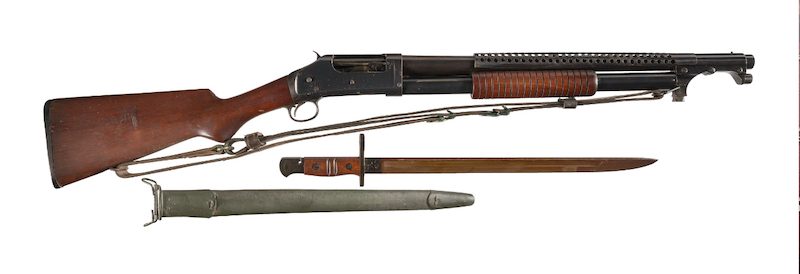It’s always fun looking through family safes and seeing what treasures they hold. Recently, I had an opportunity to check out a Winchester Model 1897 shotgun from one of those safes. We had a limited history of the shotgun, mainly family stories, but nothing concrete to tell the real story. After looking at the serial number, we tracked down the shotgun’s manufacture date and roughly where it was purchased. This information fell in line with the family story but led me down the path of learning more about this historic firearm, its origins, and legacy.
Birth of a Legend
What John Browning started in 1893 later became an upgraded and very successful pump-action, or slide-action, shotgun for hunters, law enforcement, and military. The original Model 1893 from Browning was only in production for a few years but, due to a design flaw, the action wasn’t strong enough for smokeless ammo of the time. The Model 1893 slide-action shotgun featured a checkered walnut stock with Damascus steel barrels and was available in a few different variations.

The third improvement was the use of an action slide lock. The new design required a slight movement forward of the slide handle for the shotgun to open. When firing, the recoil helped manipulate the action slide lock and the gun opened without additional movements. According to some, the inclusion of the action slide lock was a key feature that made the gun safer to use. The action slide lock holds the firing pin away from the round’s primer and kept the gun from firing until disengaging the lock. It kept the gun safe until firing and reduced jamming with a misfire according to reports.
Another improvement was a movable cartridge guide on the right side of the block to keep shells from coming out when the shotgun is turned on its side for loading. Additionally, the stock was lengthened and had less of a drop for a better fit. The Winchester Model 1897 retained the exposed hammer and magazine feed of the Model 1893.

Winchester Model 1897 Versions
At its inception, the Model 1897 was a solid frame 12-gauge shotgun with 2 ¾ inch chamber. The Take Down version and 16 gauge with 2 9/16 inch chamber were introduced in 1898 and 1899, respectively. Winchester offered the shotgun in various models: the Standard, Pigeon, Riot, Trench, Trap, and Brush, among many other models. The different models were available in 12 gauge or 16 gauge, or both, depending on the model.
Standard
Produce in large numbers, the Standard Model 97 shotgun was available in 12 or 16 gauge with a 30 or 28 inch barrel, respectively. The Standard had the features stated above, along with a plain walnut stock and steel butt plate.

Trap
The Trap version of the Model 97 had the same features, gauges, and barrel length as the Standard. Manufactured from 1897 to 1931, they featured a fancy walnut stock with etched wood checkering.
Pigeon
Produced from 1897 through 1939, the Pigeon was basically the same as the Trap with only a few small differences. First, it had a hand-engraved receiver and was only available with a 28 inch barrel.
Brush
The Brush version was originally available as a fixed frame. Later offered in fixed and take down versions, this variant had a shorter magazine with a plain walnut stock without any checkering. Ultimately retired in the 1930s, Brush models were chambered in 12 or 16 gauge with 26 inch barrel.
Riot
The Riot model was in production from 1898 through 1935. This very popular option was only available as a 12 gauge with 20 inch barrel and solid frame. The Riot model was popular among military and law enforcement agencies. The US military employed Riot and Trench versions during WWI, WWII, Korea, and Vietnam.

Trench
The Trench Model 97 was similar to the Riot model but featured a heat shield, bayonet lug, and swing swivels. The 12 gauge Trench Model 97 didn’t come along until 1917 during World War I. During this time, the Trench Model 97’s rapid-fire design became extremely popular and effective with military units in Europe. The shotgun was so handy in the trenches, as the name implies, that the Kaiser of Germany protested its use by American forces. While WWI Trench models were solid frame shotguns, the Trench models of WWII were all Take Down models.
Winchester Model 1897 Legacy
The Winchester Model 1897 really was a trendsetter and essentially the precursor of the modern pump-action shotgun. The Model 1893 and Model 1897 shotguns helped pave the way for the Winchester Model 1912. This ultimately led to the technology used with the Remington 870 and Mossberg 500 series shotguns.

Knowing the full story behind this historic shotgun adds another layer of value and awe to the shotgun. While the shotgun may not be like one that recently sold at auction for over $20,000, having a piece of family history, as much as American history, makes the shotgun invaluable to us.


